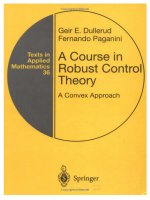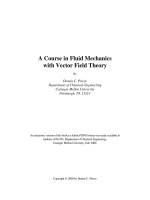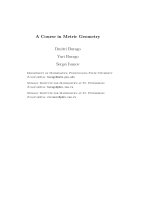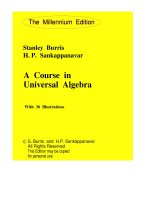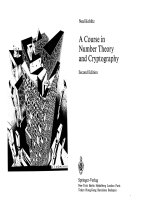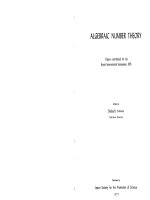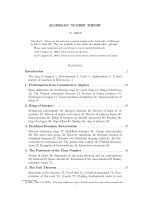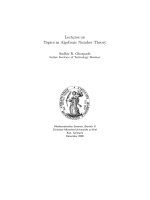A course in computational algebraic number theory, henri cohen
Bạn đang xem bản rút gọn của tài liệu. Xem và tải ngay bản đầy đủ của tài liệu tại đây (49.91 MB, 556 trang )
Graduate Texts in Mathematics
138
Editorial Board
J. H. Ewing
F. W. Gehring
P. R. Halmos
Graduate Texts in Mathematics
10 COHEN. A Course in Simple Homotopy Theory.
11 CONWAY. Functions of One Complex Variable. 2nd ed.
12 BEALS. Advanced Mathematical Analysis.
13 ANDERSON/FULLER. Rings and Categories of Modules. 2nd ed.
14 GOLUBITSKy/GUILLEMIN. Stable Mappings and Their Singularities.
15 BERBERIAN. Lectures in Functional Analysis and Operator Theory.
16 WINTER. The Structure of Fields.
17 ROSENBLATT. Random Processes. 2nd ed.
18 HALMos. Measure Theory.
19 HALMos. A Hilbert Space Problem Book. 2nd ed., revised.
20 HUSEMOLLER. Fibre Bundles. 2nd ed.
21 HUMPHREYS. Linear Algebraic Groups.
22 BARNES/MACK. An Algebraic Introduction to Mathematical Logic.
23 GREUB. Linear Algebra. 4th ed.
24 HOLMES. Geometric Functional Analysis and its Applications.
25 HEWITT/STROMBERG. Real and Abstract Analysis.
26 MANES. Algebraic Theories.
27 KELLEY. General Topology.
28 ZARISKI/SAMUEL. Commutative Algebra. Vol. I.
29 ZARISKI/SAMUEL. Commutative Algebra. Vol. II.
30 JACOBSON. Lectures in Abstract Algebra I. Basic Concepts.
31 JACOBSON. Lectures in Abstract Algebra II. Linear Algebra.
32 JACOBSON. Lectures in Abstract Algebra III. Theory of Fields and Galois Theory.
33 HIRSCH. Differential Topology.
34 SPITZER. Principles of Random Walk. 2nd ed.
35 WERMER. Banach Algebras and Several Complex Variables. 2nd ed.
36 KELLEy/NAMIOKA et al. Linear Topological Spaces.
37 MONK. Mathematical Logic.
38 GRAUERTiFRITZSCHE. Several Complex Variables.
39 ARVESON. An Invitation to C*-Algebras.
40 KEMENy/SNELLiKNAPP. Denumerable Markov Chains. 2nd ed.
41 ApOSTOL. Modular Functions and Dirichlet Series in Number Theory. 2nd ed.
42 SERRE. Linear Representations of Finite Groups.
43 GILLMAN/JERISON. Rings of Continuous Functions.
44 KENDIG. Elementary Algebraic Geometry.·
45 LoiNE. Probability Theory I. 4th ed.
46 LoiNE. Probability Theory II. 4th ed.
47 MOISE. Geometric Topology in Dimensions 2 and 3.
48 SACHSlWu. General Relativity for Mathematicians.
49 GRUENBERGIWEIR. Linear Geometry. 2nd ed.
50 EDWARDS. Fermat's Last Theorem.
51 KLINGENBERG. A Course in Differential Geometry.
52 HARTSHORNE. Algebraic Geometry.
53 MANIN. A Course in Mathematical Logic.
54 GRAVERIWATKINS. Combinatorics with Emphasis on the Theory of Graphs.
55 BROWN/PEARCY. Introduction to Operator Theory I: Elements of Functional Analysis.
56 MASSEY. Algebraic Topology: An Introduction.
Henri Cohen
A Course in
Computational
Algebraic
Number Theory
Springer-Verlag Berlin Heidelberg GmbH
Henri Cohen
U.F.R. de Mathematiques et Informatique
Universite Bordeaux I
351 Cours de la Liberation
F-33405 Talence Cedex, France
Editorial Board
J. H. Ewing
Department of Mathematics
Indiana University
Bloomington, IN 47405, USA
F. W. Gehring
Department of Mathematics
University of Michigan
Ann Arbor, MI 48109, USA
P. R. Halmos
Department of Mathematics
Santa Clara University
Santa Clara, CA 95053, USA
With 1 Figure
Mathematics Subject Classification (1991): 11 Y05, 11 Yll, 11 Y16,
l1Y40, l1A51, llC08, llC20, llR09, llRll, llR29
ISBN 978-3-642-08142-2
Library of Congress Cataloging-in-Publication Data
Cohen, Henri. A course in computational algebraic number theory / Henri Cohen. p. cm.
(Graduate texts in mathematics; 138) Includes bibliographical references ind index.
ISBN 978-3-642-08142-2
ISBN 978-3-662-02945-9 (eBook)
DOI 10.1007/978-3-662-02945-9
I. Algebraic number theory-Data processing. 1. Title. n. Series.
QA247.C55 1993 512'.74'028551-<1c20 93-3701
This work is subject to copyright. All rights are reserved, whether the whole or part of the
material is concerned, specifically the rights of translation, reprinting, reuse of illustrations,
recitation, broadcasting, reproduction on microfilms or in any other way, and storage in data
banks. Duplication of this publication or parts thereof is permitted only under the provisions of
the German Copyright Law of September 9, 1965, in its current version, and permission for use
must always be obtained from Springer-Verlag. Violations are liable for prosecution under the
German Copyright Law.
© Springer-Verlag Berlin Heidelberg 1993
Originally published by Springer-Verlag Berlin Heidelberg New York in 1993
Softcover reprint of the hardcover Ist edition 1993
The use of general descriptive names, registered names, trademarks, etc. in this publication does
not imply, even in the absence of a specific statement, that such names are exempt from the
relevant protective laws and regulations and therefore free for general use.
Typesetting: Camera-ready copy by author using AmsTEX and LamsTEX
4113140 - 5 4 3 2 I 0 - Printed on acid-free paper
Acknowledgments
This book grew from notes prepared for graduate courses in computational
number theory given at the University of Bordeaux I. When preparing this
book, it seemed natural to include both more details and more advanced
subjects than could be given in such a course. By doing this, I hope that
the book can serve two audiences: the mathematician who might only need
the details of certain algorithms as well as the mathematician wanting to go
further with algorithmic number theory.
In 1991, we started a graduate program in computational number theory
in Bordeaux, and this book was also meant to provide a framework for future
courses in this area.
In roughly chronological order I need to thank, Horst Zimmer, whose
Springer Lecture Notes on the subject [Zim] was both a source of inspiration
and of excellent references for many people at the time when it was published.
Then, certainly, thanks must go to Donald Knuth, whose (unfortunately
unfinished) series on the Art of Computer Programming ([Knu1]' [Knu2] and
[Knu3]) contains many marvels for a mathematician. In particular, the second
edition of his second volume. Parts of the contents of Chapters 1 and 3 of this
book are taken with little or no modifications from Knuth's book. In the (very
rare) cases where Knuth goes wrong, this is explicitly mentioned.
My thesis advisor and now colleague Jacques Martinet, has been very influential, both in developing the subject in Bordeaux and more generally in
the rest of France-several of his former students are now professors. He also
helped to make me aware of the beauty of the subject, since my personal
inclination was more towards analytic aspects of number theory, like modular forms or L-functions. Even during the strenuous period (for him!) when
he was Chairman of our department, he always took the time to listen or
enthusiastically explain.
I also want to thank Hendrik Lenstra, with whom I have had the pleasure
of writing a few joint papers in this area. Also Arjen Lenstra, who took the
trouble of debugging and improving a big Pascal program which I wrote, which
is still, in practice, one of the fastest primality proving programs. Together
and separately they have contributed many extremely important algorithms,
in particular LLL and its applications (see Section 2.6). My only regret is that
they both are now in the U.S.A., so collaboration is more difficult.
Acknowledgments
VI
Although he is not strictly speaking in the algorithmic field, I must also
thank Don Zagier, first for his personal and mathematical friendship and also
for his continuing invitations first to Maryland, then at the Max Planck Institute in Bonn, but also because he is a mathematician who takes both real
pleasure and real interest in creating or using algorithmic tools in number
theory. In fact, we are currently finishing a large algorithmic project, jointly
with Nils Skoruppa.
Daniel Shanks, both as an author and as editor of Mathematics of Computation, has also had a great influence on the development of algorithmic
algebraic number theory. I have had the pleasure of collaborating with him
during my 1982 stay at the University of Maryland, and then in a few subsequent meetings.
My colleagues Christian Batut, Dominique Bernardi and Michel Olivier
need to be especially thanked for the enormous amount of unrewarding work
that they put in the writing of the PARI system under my supervision. This
system is now completely operational (even though a few unavoidable bugs
crop up from time to time), and is extremely useful for us in Bordeaux, and for
the (many) people who have a copy of it elsewhere. It has been and continues
to be a great pleasure to work with them.
I also thank my colleague Francois Dress for having collaborated with
me to write our first multi-precision interpreter ISABELLE, which, although
considerably less ambitious than PARI, was a useful first step.
I met Johannes Buchmann several years ago at an international meeting.
Thanks to the administrative work of Jacques Martinet on the French side,
we now have a bilateral agreement between Bordeaux and Saarbriicken. This
has allowed several visits, and a medium term joint research plan has been
informally decided upon. Special thanks are also due to Johannes Buchmann
and Horst Zimmer for this. I need to thank Johannes Buchmann for the many
algorithms and techniques which I have learned from him both in published
work and in his preprints. A large part of this book could not have been what it
is without his direct or indirect help. Of course, I take complete responsibility
for the errors that may have appeared!
Although I have met Michael Pohst and Hans Zassenhaus 1 only in meetings and did not have the opportunity to work with them directly, they have
greatly influenced the development of modern methods in algorithmic number
theory. They have written a book [Poh-Zas] which is a landmark in the subject. I recommend it heartily for further reading, since it goes into subjects
which could not be covered in this book.
I have benefited from discussions with many other people on computational number theory, which in alphabetical order are, Oliver Atkin, AnneMarie Berge, Bryan Birch, Francisco Diaz y Diaz, Philippe Flajolet, Guy Henniart, Kevin McCurley, Jean-Francois Mestre, Francois Morain, Jean-Louis
1 Hans
Zassenhaus died on November 21, 1991.
Acknowledgments
VII
Nicolas, Joseph Oesterle, Johannes Graf von Schmettow, Jean-Pierre Serre,
Claus-Peter Schnorr, Rene Schoof, Bob Silverman, Nelson Stephens, Harold
Stark, Larry Washington. There are many others that could not be listed here.
I have taken the liberty of borrowing some of their algorithms, and I hope that
I will be forgiven if their names are not always mentioned.
The theoretical as well as practical developments in Computational Number Theory which have taken place in the last few years in Bordeaux would
probably not have been possible without a large amount of paperwork and
financial support. Hence, special thanks go to the people who made this possible, and in particular to Jean-Marc Deshouillers, Francois Dress and Jacques
Martinet as well as the relevant local and national funding committees and
agencies.
I must thank a number of persons without whose help we would have
been essentially incapable of using our workstations, in particular "Achille"
Braquelaire, Laurent Fallot, Patrick Henry, Viviane Sauquet-Deletage, Robert
Strandh and Bernard Vauquelin.
Although I do not know anybody there, I would also like to thank the
GNU project and its creator Richard Stallman, for the excellent software they
produce, which is not only free (as in "freedom", but also as in "freeware"),
but is generally superior to commercial products. Most of the software that
we use comes from GNU.
Finally, I thank all the people, too numerous to mention, who have helped
me in some way or another to improve the quality of this book, and in particular to Dominique Bernardi and Don Zagier who very carefully read drafts of
this book. But special thanks go to Gary Cornell who suggested improvements
to my English style and grammar in almost every line.
In addition, several people contributed directly or helped me write specific
sections of the book. In alphabetical order they are D. Bernardi (algorithms
on elliptic curves), J. Buchmann (Hermite normal forms and sub-exponential
algorithms), J.-M. Couveignes (number field sieve), H. W. Lenstra (in several sections and exercises), C. Pomerance (factoring and primality testing),
B. Vallee (LLL algorithms), P. Zimmermann (Appendix A).
Preface
With the advent of powerful computing tools and numerous advances in mathematics, computer science and cryptography, algorithmic number theory has
become an important subject in its own right. Both external and internal
pressures gave a powerful impetus to the development of more powerful algorithms. These in turn led to a large number of spectacular breakthroughs.
To mention but a few, the LLL algorithm which has a wide range of applications, including real world applications to integer programming, primality
testing and factoring algorithms, sub-exponential class group and regulator
algorithms, etc ...
Several books exist which treat parts of this subject. (It is essentially
impossible for an author to keep up with the rapid pace of progress in all
areas of this subject.) Each book emphasizes a different area, corresponding
to the author's tastes and interests. The most famous, but unfortunately the
oldest, is Knuth's Art of Computer Programming, especially Chapter 4.
The present book has two goals. First, to give a reasonably comprehensive
introductory course in computational number theory. In particular, although
we study some subjects in great detail, others are only mentioned, but with
suitable pointers to the literature. Hence, we hope that this book can serve
as a first course on the subject. A natural sequel would be to study more
specialized subjects in the existing literature.
The prerequisites for reading this book are contained in introductory texts
in number theory such as Hardy and Wright [H-W] and Borevitch and Shafarevitch [Bo-Sh]. The reader also needs some feeling or taste for algorithms and
their implementation. To make the book as self-contained as possible, the main
definitions are given when necessary. However, it would be more reasonable for
the reader to first acquire some basic knowledge of the subject before studying
the algorithmic part. On the other hand, algorithms often give natural proofs
of important results, and this nicely complements the more theoretical proofs
which may be given in other books.
The second goal of this course is practicality. The author's primary intentions were not only to give fundamental and interesting algorithms, but
also to concentrate on practical aspects of the implementation of these algorithms. Indeed, the theory of algorithms being not only fascinating but rich,
can be (somewhat arbitrarily) split up into four closely related parts. The first
is the discovery of new algorithms to solve particular problems. The second is
the detailed mathematical analysis of these algorithms. This is usually quite
x
Preface
mathematical in nature, and quite often intractable, although the algorithms
seem to perform rather well in practice. The third task is to study the complexity of the problem. This is where notions of fundamental importance in
complexity theory such as NP-completeness come in. The last task, which
some may consider the least noble of the four, is to actually implement the
algorithms. But this task is of course as essential as the others for the actual
resolution of the problem.
In this book we give the algorithms, the mathematical analysis and in
some cases the complexity, without proofs in some cases, especially when it
suffices to look at the existing literature such as Knuth's book. On the other
hand, we have usually tried as carefully as we could, to give the algorithms
in a ready to program form-in as optimized a form as possible. This has the
drawback that some algorithms are unnecessarily clumsy (this is unavoidable
if one optimizes), but has the great advantage that a casual user of these
algorithms can simply take them as written and program them in his/her
favorite programming language. In fact, the author himself has implemented
almost all the algorithms of this book in the number theory package PARI
(see Appendix A).
The approach used here as well as the style of presentation of the algorithms is similar to that of Knuth (analysis of algorithms excepted), and is
also similar in spirit to the book of Press et al [PFTV] Numerical Recipes (in
Fortran, Pascal or CJ, although the subject matter is completely different.
For the practicality criterion to be compatible with a book of reasonable
size, some compromises had to be made. In particular, on the mathematical
side, many proofs are not given, especially when they can easily be found
in the literature. From the computer science side, essentially no complexity
results are proved, although the important ones are stated.
The book is organized as follows. The first chapter gives the fundamental
algorithms that are constantly used in number theory, in particular algorithms
connected with powering modulo N and with the Euclidean algorithm.
Many number-theoretic problems require algorithms from linear algebra
over a field or over Z. This is the subject matter of Chapter 2. The highlights
of this chapter are the Hermite and Smith normal forms, and the fundamental
LLL algorithm.
In Chapter 3 we explain in great detail the Berlekamp-Cantor-Zassenhaus
methods used to factor polynomials over finite fields and over IQ, and we also
give algorithms for finding all the complex roots of a polynomial.
Chapter 4 gives an introduction to the algorithmic techniques used in
number fields, and the basic definitions and results about algebraic numbers
and number fields. The highlights of these chapters are the use of the Hermite
Normal Form representation of modules and ideals, an algorithm due to Diaz
y Diaz and the author for finding "simple" polynomials defining a number
field, and the subfield and field isomorphism problems.
Preface
XI
Quadratic fields provide an excellent testing and training ground for the
techniques of algorithmic number theory (and for algebraic number theory
in general). This is because although they can easily be generated, many
non-trivial problems exist, most of which are unsolved (are there infinitely
many real quadratic fields with class number I?). They are studied in great
detail in Chapter 5. In particular, this chapter includes recent advances on the
efficient computation in class groups of quadratic fields (Shanks's NUCOMP
as modified by Atkin), and sub-exponential algorithms for computing class
groups and regulators of quadratic fields (McCurley-Hafner, Buchmann).
Chapter 6 studies more advanced topics in computational algebraic number theory. We first give an efficient algorithm for computing integral bases
in number fields (Zassenhaus's round 2 algorithm), and a related algorithm
which allows us to compute explicitly prime decompositions in field extensions as well as valuations of elements and ideals at prime ideals. Then, for
number fields of degree less than or equal to 7 we give detailed algorithms
for computing the Galois group of the Galois closure. We also study in some
detail certain classes of cubic fields. This chapter concludes with a general
algorithm for computing class groups and units in general number fields. This
is a generalization of the sub-exponential algorithms of Chapter 5, and works
quite well. For other approaches, I refer to [Poh-Zas] and to a forthcoming
paper of J. Buchmann. This subject is quite involved so, unlike most other
situations in this book, I have not attempted to give an efficient algorithm,
just one which works reasonably well in practice.
Chapters 1 to 6 may be thought of as one unit and describe many of the
most interesting aspects of the theory. These chapters are suitable for a two
semester graduate (or even a senior undergraduate) level course in number
theory. Chapter 6, and in particular the class group and unit algorithm, can
certainly be considered as a climax of the first part of this book.
A number theorist, especially in the algorithmic field, must have a minimum knowledge of elliptic curves. This is the subject of chapter 7. Excellent
books exist about elliptic curves (for example [Sil]) , but our aim is a little
different since we are primarily concerned with applications of elliptic curves.
But a minimum amount of culture is also necessary, and so the flavor of this
chapter is quite different from the others chapters. In the first three sections,
we give the essential definitions, and we give the basic and most striking results
of the theory, with no pretense to completeness and no algorithms.
The theory of elliptic curves is one of the most marvelous mathematical
theories of the twentieth century, and abounds with important conjectures.
They are also mentioned in these sections. The last sections of Chapter 7,
give a number of useful algorithms for working on elliptic curves, with little
or no proofs.
The reader is warned that, apart from the material necessary for later
chapters, Chapter 7 needs a much higher mathematical background than the
other chapters. It can be skipped if necessary without impairing the understanding of the subsequent chapters.
XII
Preface
Chapter 8 (whose title is borrowed from a talk of Hendrik Lenstra) considers the techniques used for primality testing and factoring prior to the 1970's,
with the exception of the continued fraction method of Brillhart-Morrison
which belongs in Chapter 10.
Chapter 9 explains the theory and practice of the two modern primality testing algorithms, the Adleman-Pomerance-Rumely test as modified by
H. W. Lenstra and the author, which uses Fermat's (little) theorem in cyclotomic fields, and Atkin's test which uses elliptic curves with complex multiplication.
Chapter 10 is devoted to modern factoring methods, i.e. those which run
in sub-exponential time, and in particular to the Elliptic Curve Method of
Lenstra, the Multiple Polynomial Quadratic Sieve of Pomerance and the Number Field Sieve of Pollard. Since many of the methods described in Chapters
9 and 10 are quite complex, it is not reasonable to give ready-to-program algorithms as in the preceding chapters, and the implementation of anyone of
these complex methods can form the subject of a three month student project.
In Appendix A, we describe what a serious user should know about computer packages for number theory. The reader should keep in mind that the
author of this book is biased since he has written such a package himself (this
package being is available without cost by anonymous ftp).
Appendix B has a number of tables which we think may useful to the
reader. For example, they can be used to check the correctness of the implementation of certain algorithms.
What I have tried to cover in this book is so large a subject that, necessarily, it cannot be treated in as much detail as I would have liked. For further
reading, I suggest the following books.
For Chapters 1 and 3, [Knu1] and [Knu2]. This is the bible for algorithm
analysis. Note that the sections onprimality testing and factoring are outdated. Also, algorithms like the LLL algorithm which did not exist at the
time he wrote are, obviously, not mentioned. The recent book [GCL] contains
essentially all of our Chapter 3, as well as many more polynomial algorithms
which we have not covered in this book such as Grabner bases computation.
For Chapters 4 and 5, [Bo-Sh], [Mar] and [Ire-Ros]. In particular, [Mar]
and [Ire-Ros] contain a large number of practical exercises, which are not far
from the spirit of the present book, [Ire-Ros] being more advanced.
For Chapter 6, [Poh-Zas] contains a large number of algorithms, and treats
in great detail the question of computing units and class groups in general
number fields. Unfortunately the presentation is sometimes obscured by quite
complicated notations, and a lot of work is often needed to implement the
algorithms given there.
For Chapter 7, [Sill is an excellent book, unfortunately it contains only
about half of the necessary theory. It also has numerous exercises. The necessary second volume is rumored to be in preparation. Another good reference
is [Hus], as well as [Ire-Ros] for material on zeta-functions of varieties. The
Preface
XIII
algorithmic aspect of elliptic curves is beautifully treated in [Cre], which I also
heartily recommend.
For Chapters 8 to 10, the best reference to date, in addition to [Knu2]' is
[Rie]. In addition, Riesel has several chapters on prime number theory.
Note on the exercises. The exercises have a wide range of difficulty,
from extremely easy to unsolved research problems. Many are actually implementation problems, and hence not mathematical in nature. No attempt has
been made to grade the level of difficulty of the exercises as in Knuth, except
of course that unsolved problems are mentioned as such. The ordering follows
roughly the corresponding material in the text.
WARNING. Almost all of the algorithms given in this book have been
programmed by the author and colleagues, in particular as a part of the Pari
package. The programming has not however, always been synchronized with
the writing of this book, so it may be that some algorithms are incorrect, and
others may contain slight typographical errors which of course also invalidate
them. Hence, the author and Springer-Verlag do not assume any responsibility
for consequences which may directly or indirectly occur from the use of the
algorithms given in this book. Apart from the preceding legalese, the author
would appreciate corrections, improvements and so forth to the algorithms
given, so that this book may improve if further editions are printed. The
simplest is to send an e-mail message to
or else to write to the author's address.
Contents
Chapter 1. Fundamental N umber-Theoretic Algorithms
1
1.1. Introduction . .
1.1.1. Algorithms . . . . .
1.1.2. Multi-precision
1.1.3. Base Fields and Rings
1.1.4. Notations. . . . . .
1.2. The Powering Algorithms
1.3. Euclid's Algorithms . . .
1.3.1. Euclid's and Lehmer's Algorithms
1.3.2. Euclid's Extended Algorithms . .
1.3.3. The Chinese Remainder Theorem
1.3.4. Continued Fraction Expansions of Real Numbers
1.4. The Legendre Symbol . . . . . . . . .
1.4.1. The Groups (Z/nZ)* . . . . . . . . .
1.4.2. The Legendre-Jacobi-Kronecker Symbol
1.5. Computing Square Roots Modulo p . .
1.5.1. The Algorithm of Tonelli and Shanks
1.5.2. The Algorithm of Cornacchia . . . .
1.6. Solving Polynomial Equations Modulo p
1. 7. Power Detection
1.7.1. Integer Square Roots.
1.7.2. Square Detection
1.7.3. Prime Power Detection
1.8. Exercises for Chapter 1
1
1
2
5
6
8
12
12
16
19
21
24
24
27
31
32
34
36
38
38
39
41
42
Chapter 2. Algorithms for Linear Algebra and Lattices
45
2.1. Introduction . . . . . . . . . . . . . . .
2.2. Linear Algebra Algorithms on Square Matrices . .
2.2.1. Generalities on Linear Algebra Algorithms . . .
2.2.2. Gaussian Elimination and Solving Linear Systems
2.2.3. Computing Determinants . . . . . . . .
2.2.4. Computing the Characteristic Polynomial .
2.3. Linear Algebra on General Matrices
2.3.1. Kernel and Image . . . . . .
2.3.2. Inverse Image and Supplement
45
46
46
47
49
52
56
56
59
XVI
2.3.3. Operations on Subspaces
2.3.4. Remarks on Modules. .
2.4. Z-Modules and the Hermite and Smith Normal Forms
2.4.1. Introduction to Z-Modules . . . . . . .
2.4.2. The Hermite Normal Form . . . . . . .
2.4.3. Applications of the Hermite Normal Form
2.4.4. The Smith Normal Form and Applications
2.5. Generalities on Lattices . . . . . . . . .
2.5.1. Lattices and Quadratic Forms . . . . . .
2.5.2. The Gram-Schmidt Orthogonalization Procedure
2.6. Lattice Reduction Algorithms. . . . . .
2.6.1. The LLL Algorithm . . . . . . . . .
2.6.2. The LLL Algorithm with Deep Insertions
2.6.3. The Integral LLL Algorithm . . . . .
2.6.4. LLL Algorithms for Linearly Dependent Vectors
2.7. Applications of the LLL Algorithm . . . . . .
2.7.1. Computing the Integer Kernel and Image of a Matrix
2.7.2. Linear and Algebraic Dependence Using LLL
2.7.3. Finding Small Vectors in Lattices
2.8. Exercises for Chapter 2 . . . . . . .
Chapter 3. Algorithms on Polynomials
3.1. Basic Algorithms . . . . . . .
3.1.1. Representation of Polynomials.
3.1.2. Multiplication of Polynomials .
3.1.3. Division of Polynomials
3.2. Euclid's Algorithms for Polynomials
3.2.1. Polynomials over a Field . . . .
3.2.2. Unique Factorization Domains (UFD's) .
3.2.3. Polynomials over Unique Factorization Domains
3.2.4. Euclid's Algorithm for Polynomials over a UFD
3.3. The Sub-Resultant Algorithm.
3.3.1. Description of the Algorithm . . . .
3.3.2. Resultants and Discriminants . . . .
3.3.3. Resultants over a Non-Exact Domain
3.4. Factorization of Polynomials Modulo p .
3.4.1. General Strategy . . . . .
3.4.2. Squarefree Factorization . .
3.4.3. Distinct Degree Factorization
3.4.4. Final Splitting . . . . . .
3.5. Factorization of Polynomials over Z or Q .
3.5.1. Bounds on Polynomial Factors . . . .
3.5.2. A First Approach to Factoring over Z
3.5.3. Factorization Modulo pe: Hensel's Lemma
3.5.4. Factorization of Polynomials over Z . . .
Contents
61
63
65
65
66
72
74
78
78
81
83
83
89
91
94
96
96
99
102
105
108
108
108
109
110
112
112
113
115
116
117
117
118
122
123
123
124
125
126
132
133
134
136
138
Contents
XVII
3.5.5. Discussion . . . . . . . . . . . . . . . . .
3.6. Additional Polynomial Algorithms. . . . . . . .
3.6.1. Modular Methods for Computing GCD's in Z[X)
3.6.2. Factorization of Polynomials over a Number Field
3.6.3. A Root Finding Algorithm over C
3.7. Exercises for Chapter 3 . . . . .
140
141
141
142
145
147
Chapter 4. Algorithms for Algebraic Number Theory I
151
4.1. Algebraic Numbers and Number Fields . . . . . . .
4.1.1. Basic Definitions and Properties of Algebraic Numbers
4.1.2. Number Fields . . . . . . . . . . . . . . . . .
4.2. Representation and Operations on Algebraic Numbers .
4.2.1. Algebraic Numbers as Roots of their Minimal Polynomial.
4.2.2. The Standard Representation of an Algebraic Number . .
4.2.3. The Matrix (or Regular) Representation of an Algebraic Number
4.2.4. The Conjugate Vector Representation of an Algebraic Number
4.3. Trace, Norm and Characteristic Polynomial . . . . .
4.4. Discriminants, Integral Bases and Polynomial Reduction
4.4.1. Discriminants and Integral Bases
4.4.2. The Polynomial Reduction Algorithm
4.5. The Subfield Problem and Applications
4.5.1. The Subfield Problem Using the LLL Algorithm
4.5.2. The Subfield Problem Using Linear Algebra over C
4.5.3. The Subfield Problem Using Algebraic Algorithms .
4.5.4. Applications of the Solutions to the Subfield Problem
4.6. Orders and Ideals .
4.6.1. Basic Definitions
4.6.2. Ideals of ZK
4.7. Representation of Modules and Ideals
4.7.1. Modules and the Hermite Normal Form
4.7.2. Representation of Ideals . . . .
4.8. Decomposition of Prime Numbers I . . .
4.8.1. Definitions and Main Results . . . . .
4.8.2. A Simple Algorithm for the Decomposition of Primes
4.8.3. Computing Valuations . . . . .
4.8.4. Ideal Inversion and the Different .
4.9. Units and Ideal Classes
4.9.1. The Class Group
4.9.2. Units and the Regulator
4.9.3. Conclusion: the Main Computational Tasks of Algebraic
Number Theory . .
4.10. Exercises for Chapter 4 . . . . . . . . . . . . . . .
151
151
152
156
156
157
158
159
160
163
163
166
172
172
173
175
177
179
179
184
186
186
188
193
194
196
198
202
205
205
206
214
215
XVIII
Contents
Chapter 5. AlgorithIlls for Quadratic Fields .
218
5.1. Discriminant, Integral Basis and Decomposition of Primes
5.2. Ideals and Quadratic Forms . . . . . . . . . .
5.3. Class Numbers of Imaginary Quadratic Fields
5.3.1. Computing Class Numbers Using Reduced Forms
5.3.2. Computing Class Numbers Using Modular Forms
5.3.3. Computing Class Numbers Using Analytic Formulas
5.4. Class Groups of Imaginary Quadratic Fields
5.4.1. Shanks's Baby Step Giant Step Method
5.4.2. Reduction and Composition of Quadratic Forms
5.4.3. Class Groups Using Shanks's Method
5.5. McCurley's Sub-exponential Algorithm
5.5.1. Outline of the Algorithm . . . . . .
5.5.2. Detailed Description of the Algorithm
5.5.3. Atkin's Variant . . . . . . . . . .
5.6. Class Groups of Real Quadratic Fields .
5.6.1. Computing Class Numbers Using Reduced Forms
5.6.2. Computing Class Numbers Using Analytic Formulas
5.6.3. A Heuristic Method of Shanks. . . . . . . . . .
5.7. Computation of the Fundamental Unit and of the Regulator
5.7.1. Description of the Algorithms . . . . . . .
5.7.2. Analysis of the Continued Fraction Algorithm
5.7.3. Computation of the Regulator. . .
5.8. The Infrastructure Method of Shanks
5.8.1. The Distance Function . . . . . .
5.8.2. Description of the Algorithm . . .
5.8.3. Compact Representation of the Fundamental Unit
5.8.4. Other Application and Generalization of the Distance Function
5.9. Buchmann's Sub-exponential Algorithm . . . . . . . . . . .
5.9.1. Outline of the Algorithm . . . . . . . . . . . . . . . . .
5.9.2. Detailed Description of Buchmann's Sub-exponential Algorithm
5.10. The Cohen-Lenstra Heuristics . . . . . . . . . . . .
5.10.1. Results and Heuristics for Imaginary Quadratic Fields.
5.10.2. Results and Heuristics for Real Quadratic Fields
5.11. Exercises for Chapter 5 . . . . . . . . . . . . . . .
218
220
226
226
229
232
235
235
238
245
247
247
250
255
257
257
261
263
264
264
266
273
274
274
278
280
282
283
284
286
289
290
292
293
Chapter 6. AlgorithIllS for Algebraic NUIllber Theory II
297
6.1. Computing the Maximal Order .
6.1.1. The Pohst-Zassenhaus Theorem .
6.1.2. The Dedekind Criterion . . . .
6.1.3. Outline of the Round 2 Algorithm
6.1.4. Detailed Description of the Round 2 Algorithm
6.2. Decomposition of Prime Numbers II . . . . . .
6.2.1. Newton Polygons . . . . . . . . . . . . .
6.2.2. Theoretical Description of the Buchmann-Lenstra Method
297
297
299
302
305
306
307
309
Contents
XIX
6.2.3. Multiplying and Dividing Ideals Modulo p . . . . . . . . .
6.2.4. Splitting of Separable Algebras over Fp . • • . . . . . . . •
6.2.5. Detailed Description of the Algorithm for Prime Decomposition
6.3. Computing Galois Groups
6.3.1. The Resolvent Method
6.3.2. Degree 3
6.3.3. Degree 4
6.3.4. Degree 5
6.3.5. Degree 6
6.3.6. Degree 7
6.3.7. A List of Test Polynomials
6.4. Examples of Families of Number Fields
6.4.1. Making Tables of Number Fields
6.4.2. Cyclic Cubic Fields . . . . . . . .
6.4.3. Pure Cubic Fields . . . . . . . . .
6.4.4. Decomposition of Primes in Pure Cubic Fields
6.4.5. General Cubic Fields. . . . . . . . . . . .
6.5. Computing the Class Group, Regulator and Fundamental Units
6.5.1. Ideal Reduction . . . . . . . . . . . . . . . . . . . .
6.5.2. Computing the Relation Matrix . . . . . . . . . . . . .
6.5.3. Computing the Regulator and a System of Fundamental Units
6.5.4. The General Class Group and Unit Algorithm.
6.5.5. The Principal Ideal Problem
6.6. Exercises for Chapter 6 . . . . . . . . .
311
312
314
316
316
319
319
322
323
325
327
328
328
330
337
341
345
346
346
348
351
352
354
356
Chapter 7. Introduction to Elliptic Curves
7.1. Basic Definitions
7.1.1. Introduction
.......... .
7.1.2. Elliptic Integrals and Elliptic Functions
7.1.3. Elliptic Curves over a Field . . . . . .
7.1.4. Points on Elliptic Curves . . . . . . .
7.2. Complex Multiplication and Class Numbers
7.2.1. Maps Between Complex Elliptic Curves
7.2.2. Isogenies . . . . . . . . . . . . . . .
7.2.3. Complex Multiplication . . . . . . . .
7.2.4. Complex Multiplication and Hilbert Class Fields
7.2.5. Modular Equations . . . . .
7.3. Rank and L-functions . . . . .
7.3.1. The Zeta Function of a Variety
7.3.2. L-functions of Elliptic Curves .
7.3.3. The Taniyama-Weil Conjecture
7.3.4. The Birch and Swinnerton-Dyer Conjecture
7.4. Algorithms for Elliptic Curves . . . . .
7.4.1. Algorithms for Elliptic Curves over C
7.4.2. Algorithm for Reducing a General Cubic
360
360
360
360
362
365
369
370
372
374
377
378
379
380
381
383
385
387
387
392
xx
Contents
7.4.3. Algorithms for Elliptic Curves over IFp
7.5. Algorithms for Elliptic Curves over Q
7.5.1. Tate's algorithm . . . . . . . . . .
7.5.2. Computing rational points . . . . .
7.5.3. Algorithms for computing the L-function
7.6. Algorithms for Elliptic Curves with Complex Multiplication
7.6.1. Computing the Complex Values of j(r) . .
7.6.2. Computing the Hilbert Class Polynomials .
7.6.3. Computing Weber Class Polynomials.
7.7. Exercises for Chapter 7 . . . . . . .
396
399
399
402
405
407
407
408
408
409
Chapter 8. Factoring in the Dark Ages
412
8.1. Factoring and Primality Testing.
8.2. Compositeness Tests. . . . . . . .
8.3. Primality Tests . . . . . . . . . .
8.3.1. The Pocklington-Lehmer N - 1 Test
8.3.2. Briefly, Other Tests
8.4. Lehmann's Method . .
8.5. Pollard's p Method . .
8.5.1. Outline of the Method
8.5.2. Methods for Detecting Periodicity
8.5.3. Brent's Modified Algorithm .
8.5.4. Analysis of the Algorithm
8.6. Shanks's Class Group Method
8.7. Shanks's SQUFOF
8.8. The p - I-method .
8.8.1. The First Stage .
8.8.2. The Second Stage
8.8.3. Other Algorithms of the Same Type
8.9. Exercises for Chapter 8 . . . . .
412
414
416
416
417
418
419
419
420
422
423
426
427
431
432
433
434
435
Chapter 9. Modern Primality Tests
437
9.1. The Jacobi Sum Test
9.1.1. Group Rings of Cyclotomic Extensions
9.1.2. Characters, Gauss Sums and Jacobi Sums
9.1.3. The Basic Test . . . .
9.1.4. Checking Condition Cp • • • • • • •
9.1.5. The Use of Jacobi Sums . . . . . .
9.1.6. Detailed Description of the Algorithm
9.1.7. Discussion . . . . . . .
9.2. The Elliptic Curve Test
9.2.1. The Goldwasser-Kilian Test
9.2.2. Atkin's Test
9.3. Exercises for Chapter 9
438
438
440
442
447
449
455
457
459
459
463
467
Contents
XXI
Chapter 10. Modern Factoring Methods
469
10.1. The Continued Fraction Method
10.2. The Class Group Method . . . . . . .
10.2.1. Sketch of the Method . . . . . . . .
10.2.2. The Schnorr-Lenstra Factoring Method
10.3. The Elliptic Curve Method
10.3.1. Sketch of the Method . . . . . . . .
10.3.2. Elliptic Curves Modulo N . . . . . .
10.3.3. The ECM Factoring Method of Lenstra
10.3.4. Practical Considerations . . . . . . .
10.4. The Multiple Polynomial Quadratic Sieve
10.4.1. The Basic Quadratic Sieve Algorithm .
10.4.2. The Multiple Polynomial Quadratic Sieve
10.4.3. Improvements to the MPQS Algorithm
10.5. The Number Field Sieve . . . . . . . .
10.5.1. Introduction . . . . . . . . . . . . .
10.5.2. Description of the Special NFS when h(K) = 1
10.5.3. Description of the Special NFS when h(K) > 1
10.5.4. Description of the General NFS . . . . . .
10.5.5. Miscellaneous Improvements to the Number Field Sieve
10.6. Exercises for Chapter 10 . . . . . . . .
469
473
473
474
476
476
477
479
481
482
483
484
486
487
487
488
492
493
495
496
Appendix A. Packages for Number Theory
498
Appendix B. Some Useful Tables . . . . .
B.1. Table of Class Numbers of Complex Quadratic Fields
B.2. Table of Class Numbers and Units of Real Quadratic Fields
B.3. Table of Class Numbers and Units of Complex Cubic Fields
B.4. Table of Class Numbers and Units of Totally Real Cubic Fields.
B.5. Table of Elliptic Curves
503
503
505
509
511
514
Bibliography.
517
Index. . . . .
529
Chapter 1
Fundamental N umber-Theoretic Algorithms
1.1 Introduction
This book describes in detail a number of algorithms used in algebraic number
theory and the theory of elliptic curves. It also gives applications to problems
such as factoring and primality testing. Although the algorithms and the theory behind them are sufficiently interesting in themselves, I strongly advise
the reader to take the time to implement them on her Ihis favorite machine.
Indeed, one gets a feel for an algorithm mainly after executing it several times.
(This book does help by providing many tricks that will be useful for doing
this.)
We give the necessary background on number fields and classical algebraic
number theory in Chapter 4, and the necessary prerequisites on elliptic curves
in Chapter 7. This chapter shows you some basic algorithms used almost
constantly in number theory. The best reference here is [Knu2].
1.1.1 Algorithms
Before we can describe even the simplest algorithms, it is necessary to precisely define a few notions. However, we will do this without entering into the
sometimes excessively detailed descriptions used in Computer Science. For us,
an algorithm will be a method which, given certain types of inputs, gives an
answer after a finite amount of time.
Several things must be considered when one describes an algorithm. The
first is to prove is that it is correct, i.e. that it gives the desired result when
it stops. Then, since we are interested in practical implementations, we must
give an estimate of the algorithm's running time, if possible both in the worst
case, and on average. Here, one must be careful: the running time will always
be measured in bit operations, i.e. logical or arithmetic operations on zeros and
ones. This is the most realistic model, if one assumes that one is using real
computers, and not idealized ones. Third, the space requirement (measured in
bits) must also be considered. In many algorithms, this is negligible, and then
we will not bother mentioning it. In certain algorithms however, it becomes
an important issue which has to be addressed.
First, some useful terminology: The size of the inputs for an algorithm will
usually be measured by the number of bits that they require. For example,
the size of a positive integer N is llg N J + 1 (see below for notations). We
2
1 Fundamental Number-Theoretic Algorithms
will say that an algorithm is linear, quadratic or polynomial time if it requires
time O(lnN), 0(ln2 N), O(P(lnN)) respectively, where P is a polynomial. If
the time required is O(Na), we say that the algorithm is exponential time.
Finally, many algorithms have some intermediate running time, for example
eCY'ln N In In N
,
which is the approximate expected running time of many factoring algorithms
and of recent algorithms for computing class groups. In this case we say that
the algorithm is sub-exponential.
The definition of algorithm which we have given above, although a little
vague, is often still too strict for practical use. We need also probabilistic
algorithms, which depend on a source of random numbers. These "algorithms"
should in principle not be called algorithms since there is a possibility (of
probability zero) that they do not terminate. Experience shows, however, that
probabilistic algorithms are usually more efficient than non-probabilistic ones;
in many cases they are even the only ones available.
Probabilistic algorithms should not be mistaken with methods (which I
refuse to call algorithms), which produce a result which has a high probability
of being correct. It is essential that an algorithm produces correct results
(discounting human or computer errors), even if this happens after a very
long time. A typical example of a non-algorithmic method is the following:
suppose N is large and you suspect that it is prime (because it is not divisible
by small numbers). Then you can compute
2N -
1
modN
using the powering Algorithm 1.2.1 below. If it is not 1 mod N, then this
proves that N is not prime by Fermat's theorem. On the other hand, if it is
equal to 1 mod N, there is a very good chance that N is indeed a prime. But
this is not a proof, hence not an algorithm for primality testing (the smallest
counterexample is N = 341).
Another point to keep in mind for probabilistic algorithms is that the idea
of absolute running time no longer makes much sense. This is replaced by the
notion of expected running time, which is self-explanatory.
1.1.2 Multi-precision
Since the numbers involved in our algorithms will almost always become quite
large, a prerequisite to any implementation is some sort of multi-precision
package. This package should be able to handle numbers having up to 1000
decimal digits. Such a package is easily to write, and one is described in detail
in Riesel's book ([Riel). One can also use existing packages or languages, such
as Axiom, Bignum, Cayley/Magma, Derive, Gmp, Lisp, Macsyma, Maple,
Mathematica, Pari, Reduce, or Ubasic (see Appendix A). Even without a
1.1 Introduction
3
multi-precision package, some algorithms can be nicely tested, but their scope
becomes more limited.
The pencil and paper method for doing the usual operations can be implemented without difficulty. One should not use a base-lO representation, but
rather a base suited to the computer's hardware.
Such a bare-bones multi-precision package must include at the very least:
• Addition and subtraction of two n-bit numbers (time linear in n).
• Multiplication and Euclidean division of two n-bit numbers (time linear
in n 2 ).
• Multiplication and division of an n-bit number by a short integer (time
linear in n). Here the meaning of short integer depends on the machine. Usually
this means a number of absolute value less than 215 , 231 , 235 or 263 .
• Left and right shifts of an n bit number by small integers (time linear
in n).
• Input and output of an n-bit number (time linear in n or in n 2 depending
whether the base is a power of 10 or not.
Remark. Contrary to the choice made by some systems such as Maple, I
strongly advise using a power of 2 as a base, since usually the time needed for
input/output is only a very small part of the total time, and it is also often
dominated by the time needed for physical printing or displaying the results.
There exist algorithms for multiplication and division which as n gets
large are much faster than O(n2), the best, due to Schonhage and Strassen,
running in O( n In n In In n) bit operations. Since we will be working mostly
with numbers of up to roughly 100 decimal digits, it is not worthwhile to
implement these more sophisticated algorithms. (These algorithms become
practical only for numbers having more than several hundred decimal digits.)
On the other hand, simpler schemes such as the method of Karatsuba (see
[Knu2] and Exercise 2) can be useful for much smaller numbers.
The times given above for the basic operations should constantly be kept
in mind.
Implementation advice. For people who want to write their own barebones multi-precision package as described above, by far the best reference
is [Knu2] (see also [Riel). A few words of advice are however necessary. A
priori, one can write the package in one's favorite high level language. As
will be immediately seen, this limits the multi-precision base to roughly the
square root of the word size. For example, on a typical 32 bit machine, a
high level language will be able to multiply two 16-bit numbers, but not two
32-bit ones since the result would not fit. Since the multiplication algorithm
used is quadratic, this immediately implies a loss of a factor 4, which in fact
usually becomes a factor of 8 or 10 compared to what could be done with the
machine's central processor. This is intolerable. Another alternative is to write
everything in assembly language. This is extremely long and painful, usually
4
1 Fundamental Number-Theoretic Algorithms
bug-ridden, and in addition not portable, but at least it is fast. This is the
solution used in systems such as Pari and Ubasic, which are much faster than
their competitors when it comes to pure number crunching.
There is a third possibility which is a reasonable compromise. Declare
global variables (known to all the files, including the assembly language files
if any) which we will call remainder and overflow say.
Then write in any way you like (in assembly language or as high level
language macros) nine functions that do the following. Assume a, b ,c are
unsigned word-sized variables, and let Mbe the chosen multi-precision base,
so all variables will be less than M (for example M= 232 ). Then we need the
following functions, where 0 ~ c < Mand overflow is equal to 0 or 1:
c=add(a, b) corresponding to the formula a+b=overflow·M+c.
c=add.x(a, b) corresponding to the formula a+b+overflow=overflow·M+c.
c=sub(a, b) corresponding to the formula a-b=c-overflow·M.
c=subx(a, b) corresponding to the formula a-b-overflow=c-overflow·M.
c=mul(a, b) corresponding to the formula a·b=remainder·M+c,
in other words c contains the low order part of the product, and remainder
the high order part.
c=div(a, b) corresponding to the formula remainder·M+a=b·c+remainder,
where we may assume that remainder
M= 2m.
c=shiftl(a,k) corresponding to the formula 2k a=reinainder·M+c.
c=shiftr(a,k) corresponding to the formula a.M/2 k =c·M+remainder,
where we assume for these last two functions that 0 ~ k < m.
k=bfffo(a) corresponding to the formula M/2 ~ 2k a < M, i.e. k
Pg(M/(2a))l when a =I- 0, k = m when a = O.
The advantage of this scheme is that the rest of the multi-precision package
can be written in a high level language without much sacrifice of speed, and
that the black boxes described above are short and easy to write in assembly
language. The portability problem also disappears since these functions can
easily be rewritten for another machine.
Knowledgeable readers may have noticed that the functions above correspond to a simulation of a few machine language instructions of the
68020/68030/68040 processors. It may be worthwhile to work at a higher
level, for example by implementing in assembly language a few of the multiprecision functions mentioned at the beginning of this section. By doing this
to a limited extent one can avoid many debugging problems. This also avoids
much function call overhead, and allows easier optimizing. As usual, the price
paid is portability and robustness.
Remark. One of the most common operations used in number theory is
modular multiplication, i.e. the computation of a * b modulo some number
N, where a and b are non-negative integers less than N. This can, of course,
1.1 Introduction
5
be trivially done using the formula div(mul(a,b) ,N), the result being the
value of remainder. When many such operations are needed using the same
modulus N (this happens for example in most factoring methods, see Chapters
8, 9 an 10), there is a more clever way of doing this, due to P. Montgomery
which can save 10 to 20 percent of the running time, and this is not a negligible
saving since it is an absolutely basic operation. We refer to his paper [Mon1]
for the description of this method.
1.1.3 Base Fields and Rings
Many of the algorithms that we give (for example the linear algebra algorithms of Chapter 2 or some of the algorithms for working with polynomials
in Chapter 3) are valid over any base ring or field R where we know how to
compute. We must emphasize however that the behavior of these algorithms
will be quite different depending on the base ring. Let us look at the most
important examples.
The simplest rings are the rings R = Z/NZ, especially when N is small.
Operations in R are simply operations "modulo N" and the elements of R can
always be represented by an integer less than N, hence of bounded size. Using
the standard algorithms mentioned in the preceding section, and a suitable
version of Euclid's extended algorithm to perform division (see Section 1.3.2),
all operations need only 0(ln2 N) bit operations (in fact 0(1) since N is considered as fixed!). An important special case of these rings R is when N = p
is a prime, and then R = IF p the finite field with p elements. More generally,
it is easy to see that operations on any finite field IF q with q = pk can be done
quickly.
The next example is that of R = Z. In many algorithms, it is possible to
give an upper bound N on the size of the numbers to be handled. In this case
we are back in the preceding situation, except that the bound N is no longer
fixed, hence the running time of the basic operations is really 0(ln2 N) bit
operations and not 0(1). Unfortunately, in most algorithms some divisions
are needed, hence we are no longer working in Z but rather in Q. It is possible
to rewrite some of these algorithms so that non-integral rational numbers
never occur (see for example the Gauss-Bareiss Algorithm 2.2.6, the integral
LLL Algorithm 2.6.7, the sub-resultant Algorithms 3.3.1 and 3.3.7). These
versions are then preferable.
The third example is when R = Q. The main phenomenon which occurs
in practically all algorithms here is "coefficient explosion" . This means that in
the course of the algorithm the numerator and denominators of the rational
numbers which occur become very large; their size is almost impossible to
control. The main reason for this is that the numerator and denominator of
the sum or difference of two rational numbers is usually of the same order
of magnitude as those of their product. Consequently it is not easy to give
running times in bit operations for algorithms using rational numbers.

